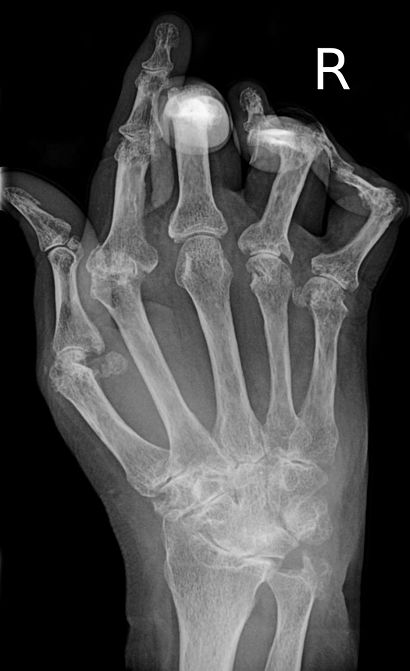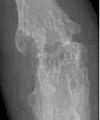Rheumatoid arthritis facts for kids
Quick facts for kids Rheumatoid arthritis |
|
|---|---|
 |
|
| X-ray of the hand in rheumatoid arthritis. | |
| Symptoms | Warm, swollen, painful joints |
| Complications | Low red blood cells, inflammation around the lungs, inflammation around the heart |
| Usual onset | Middle age |
| Duration | Lifelong |
| Causes | Unknown |
| Diagnostic method | Based on symptoms, medical imaging, blood tests |
| Similar conditions | Systemic lupus erythematosus, psoriatic arthritis, fibromyalgia |
| Medication | Pain medications, steroids, Nonsteroidal anti-inflammatory drugs, disease-modifying antirheumatic drugs |
| Frequency | 0.5–1% (adults in developed world) |
| Deaths | 30,000 (2015) |
Rheumatoid arthritis (RA) is a serious and long-lasting disease that causes pain. It is an autoimmune disease. This means your body's defense system, called the immune system, accidentally attacks its own healthy cells.
When someone has RA, their immune system attacks the joints. It also attacks the tissues around the joints. This can cause several problems:
- The areas around the joints become swollen.
- The body makes too much synovial fluid. This fluid usually helps cushion the joints.
- Tough tissue can build up in the synovium area. This area also helps to cushion the joints.
Over time, RA can damage the cartilage in your joints. Cartilage normally covers the ends of bones where they meet. It stops the bones from rubbing against each other. If RA destroys this cartilage, the bones will rub. This causes a lot of pain.
No one knows exactly what causes RA. Some ideas include hormones, things in the environment, and genes. There is no cure for RA right now. However, doctors have found ways to slow down the disease. They can also reduce its effects. Women are two to three times more likely to get RA than men. Most people get RA between the ages of 25 and 55.
RA was first identified around the year 1800. A doctor named Augustin Jacob Landré-Beauvais recognized it.
What Are the Signs of RA?
The signs of rheumatoid arthritis can include:
- Swelling, stiffness, and pain around affected joints.
- A mild fever.
- Feeling uncomfortable and very tired.
Often, people with RA also get anemia. This is a different condition. It means a person does not have enough healthy blood cells.
Less often, someone with RA might have:
- Inflamed blood vessels.
- Pain in their neck.
Images for kids
See also
 In Spanish: Artritis reumatoide para niños
In Spanish: Artritis reumatoide para niños




